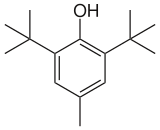Butylated hydroxytoluene
 |
|
 |
|
| Names | |
|---|---|
|
Preferred IUPAC name
2,6-Di-tert-butyl-4-methylphenol
|
|
| Other names
2,6-Di-tert-butyl-p-cresol
3,5-Di-tert-butyl-4-hydroxytoluene DBPC BHT E321 AO-29 Avox BHT Additin RC 7110 Dibutylated hydroxytoluene 4-Methyl-2,6-di-tert-butyl phenol |
|
| Identifiers | |
|
128-37-0 |
|
| 3D model (Jmol) | Interactive image |
| ChEBI |
CHEBI:34247 |
| ChEMBL |
ChEMBL146 |
| ChemSpider |
13835296 |
| ECHA InfoCard | 100.004.439 |
| EC Number | 204-881-4 |
| E number | E321 (antioxidants, ...) |
| KEGG |
D02413 |
| RTECS number | GO7875000 |
| UNII |
1P9D0Z171K |
|
|
|
|
| Properties | |
| C15H24O | |
| Molar mass | 220.36 g·mol−1 |
| Appearance | White to yellow powder |
| Odor | slight, phenolic |
| Density | 1.048 g/cm3 |
| Melting point | 70 °C (158 °F; 343 K) |
| Boiling point | 265 °C (509 °F; 538 K) |
| 1.1 mg/L (20 °C) | |
| Vapor pressure | 0.01 mmHg (20°C) |
| Hazards | |
| Main hazards | Flammable |
| Safety data sheet | External MSDS |
| R-phrases | R22-R36-R37-R38 |
| S-phrases | S26-S36 |
| NFPA 704 | |
| Flash point | 127 °C (261 °F; 400 K) |
| US health exposure limits (NIOSH): | |
|
PEL (Permissible)
|
none |
|
REL (Recommended)
|
TWA 10 mg/m3 |
|
IDLH (Immediate danger)
|
N.D. |
| Related compounds | |
|
Related compounds
|
Butylated hydroxyanisole |
|
Except where otherwise noted, data are given for materials in their standard state (at 25 °C [77 °F], 100 kPa).
|
|
|
|
|
| Infobox references | |
Butylated hydroxytoluene (BHT), also known as dibutylhydroxytoluene, is a lipophilic organic compound, chemically a derivative of phenol, that is useful for its antioxidant properties. European and U.S. regulations allow small amounts to be used as a food additive. In addition to this use, BHT is widely used to prevent oxidation in fluids (e.g. fuel, oil) and other materials where free radicals must be controlled.
Phytoplankton, including the green algae Botryococcus braunii, as well as three different cyanobacteria (Cylindrospermopsis raciborskii, Microcystis aeruginosa and Oscillatoria sp.) are capable of producing BHT. Confirmation was made via gas chromatography–mass spectrometry analysis.
Industrially, BHT is prepared by the reaction of p-cresol (4-methylphenol) with isobutylene (2-methylpropene) catalyzed by sulfuric acid:
Alternatively, BHT is prepared from 2,6-di-tert-butylphenol by hydroxymethylation or aminomethylation followed by hydrogenolysis.
The species behaves as a synthetic analog of vitamin E, primarily acting as a terminating agent that suppresses autoxidation, a process whereby unsaturated (usually) organic compounds are attacked by atmospheric oxygen. BHT stops this reaction by converting peroxy radicals to hydroperoxides. It effects this function by donating a hydrogen atom:
...
Wikipedia

